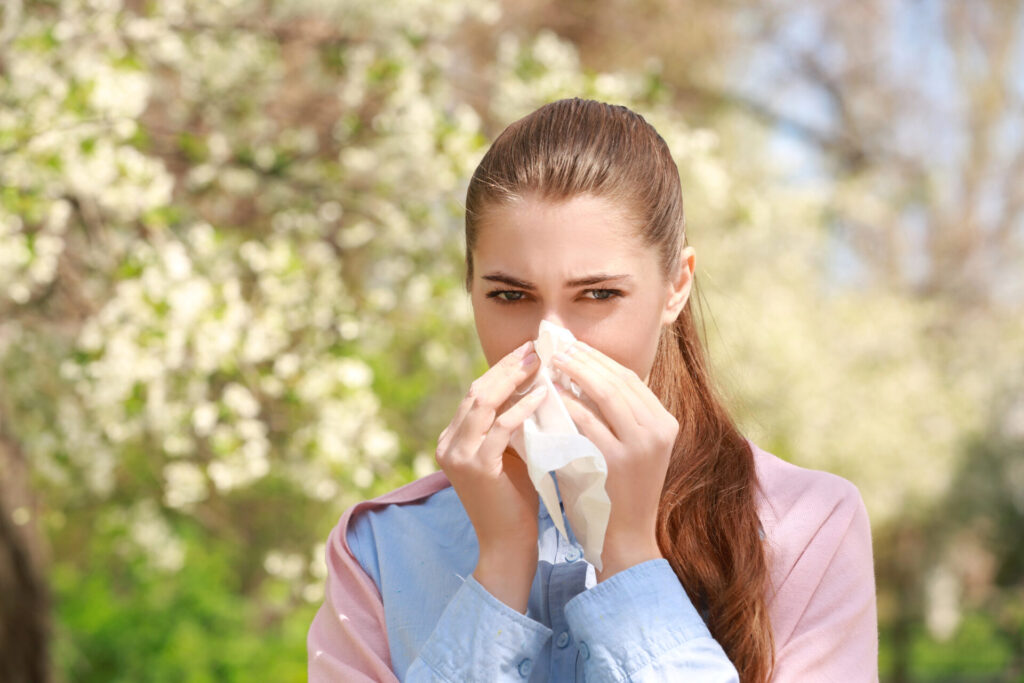Spring is a difficult time of year for many patients, due to the onset of seasonal allergies. In my clinical practice, I’ve found that employing a number of strategies can support the health of patients with seasonal allergies as well as allergic conditions such as asthma. In this article, I will address what I find to be an effective approach.
Address Cross-Reactivities
This is an often overlooked aspect of treating patients with allergies. Cross-reactivities refers to the cross-reaction that occurs between pollen/other allergens and specific types of food. For example, someone who reacts to birch pollen may also react to apples, carrots, celery, apricots, and hazelnuts, to name a few of the cross-reacting foods. For more examples, see table 1 below.
Table 1: Cross-Reactions Between Pollen and Food
| Birch | Apples, peaches, plums, pears, cherries, apricots, almonds, carrots, celery, parsley, caraway, fennel, coriander, aniseed, soybeans, peanuts, hazelnuts |
| Ragweed | Cantaloupe, honeydew, watermelon, zucchini, cucumber, banana |
| Mugwort | Celery, carrots, parsley, caraway, fennel, coriander, aniseed, bell peppers, black pepper, mustard, cauliflower, cabbage, broccoli, garlic, onions, peaches |
Although these foods can cause problems throughout the year, when a particular type of airborne allergen is prevalent, eating any of the cross-reacting foods can be particularly troublesome.
I usually consult pollen.com to see what pollen levels are present and suggest allergic patients remove the appropriate cross-reacting foods from their diets. I also order food sensitivity testing.
Supplemental Support for Allergies and Asthma
The second approach I use with my allergies and asthma patients is to recommend a good immune supplement with ingredients as discussed below, along with vitamin D3 and bioavailable quercetin.
Astragalus
Astragalus supports the health of patients with seasonal allergic rhinitis.1 It may reduce a runny nose and improve the quality of life in allergy patients.1
Yeast-Based Fermentate (EpiCor®)
Researchers have studied a yeast-based fermentate known as EpiCor® to reduce the symptoms of seasonal allergies by increasing levels of secretory IgA, which supports the health of the mucous membranes. They found that the yeast-based fermentate reduced congestion and runny nose in allergy sufferers during the 12 weeks of the highest recorded levels of total pollen counts for a Midwest geographic area.2
Berberine
In preclinical and cell culture studies, berberine promoted immune system health. In mice, it supported a healthy inflammatory response in the lungs.3
Olive Leaf Extract
A randomized, placebo-controlled study of 32 high school athletes found that olive leaf extract supported upper respiratory tract health.4 One of the most important components of olive leaf is oleuropein. Tru Immune Support contains olive leaf extract with a generous 16% oleuropein for optimal potency.
Vitamin C and Zinc
Vitamin C and zinc are two nutrients shown to support allergy patients. Vitamin C promotes bronchial health in seasonal allergy patients.5 Deficiencies in nutrients like zinc are associated with allergies.6
Garlic
This herb contains allicin, garlic’s active component that was shown in a human study to keep subjects’ immune systems healthy.7
Citrus Bioflavonoids
Interleukin-5 (IL-5) is a strong trigger for the asthmatic inflammatory response. Citrus bioflavonoids significantly suppress IL-5 and are therefore thought to be soothing to asthma patients.8
N-Acetyl Cysteine (NAC)
NAC is a precursor to glutathione, the master antioxidant. NAC is known for its ability to reduce mucous in the nasal passages and to help maintain respiratory health.9
Vitamin D3
In northern latitudes where people aren’t getting as much vitamin D from sun exposure, the rates of food allergy/anaphylaxis are higher compared to in latitudes where people are exposed to more sunlight.10 Research links asthma, eczema, and atopy to low vitamin D levels.11 This makes sense because vitamin D can trigger immune system cells that block the release of chemicals that cause and worsen allergic diseases.12
Other Anti-Allergy Strategies I Use in Clinical Practice
Finally, here are some other approaches I recommend to patients who are battling seasonal allergies:
- Keep your home’s doors and windows closed.
- Turn on the air-conditioning rather than opening a window.
- Avoid exercising outside during peak pollen counts.
- Minimize your time spent outdoors on windy days.
- While driving, keep your car windows and sunroof closed. Keep the air on re-circulate.
- Take a shower before going to bed, making sure to wash your hair to remove the pollen that built up during the day.
- Change your clothes after being outside to avoid contaminating your home.
References
- Matkovic Z, Zivkovic V, Korica M, Plavec D, Pecanic S, Tudoric N. Efficacy and safety of Astragalus membranaceus in the treatment of patients with seasonal allergic rhinitis. Phytother Res. 2010;24(2):175-181.
- Moyad MA, Robinson LE, Kittelsrud JM, et al. Immunogenic yeast-based fermentation product reduces allergic rhinitis-induced nasal congestion: a randomized, double-blind, placebo-controlled trial. Adv Ther. 2009;26(8):795-804.
- Yan YQ, Fu YJ, Wu S, et al. Anti-influenza activity of berberine improves prognosis by reducing viral replication in mice. Phytother Res. 2018;32(12):2560-2567.
- Somerville V, Moore R, Braakhuis A. The Effect of Olive Leaf Extract on Upper Respiratory Illness in High School Athletes: A Randomised Control Trial. Nutrients. 2019;11(2).
- Bucca C, Rolla G, Oliva A, Farina JC. Effect of vitamin C on histamine bronchial responsiveness of patients with allergic rhinitis. Ann Allergy. 1990;65(4):311-314.
- Xu H, Tong K, Iwasaki N, et al. Alleviating effect of intranasal zinc on symptoms of allergic rhinitis. J Allergy Clin Immunol Glob. 2025;4(2):100408.
- Josling P. Preventing the common cold with a garlic supplement: a double-blind, placebo-controlled survey. Adv Ther. 2001;18(4):189-193.
- Yang WL, Chen SY, Ho CY, Yen GC. Citrus flavonoids suppress IL-5 and ROS through distinct pathways in PMA/ionomycin-induced EL-4 cells. Food Funct. 2020;11(1):824-833.
- Mokra D, Mokry J, Barosova R, Hanusrichterova J. Advances in the Use of N-Acetylcysteine in Chronic Respiratory Diseases. Antioxidants (Basel). 2023;12(9).
- Mullins RJ, Camargo CA. Latitude, sunlight, vitamin D, and childhood food allergy/anaphylaxis. Curr Allergy Asthma Rep. 2012;12(1):64-71.
- Searing DA, Leung DY. Vitamin D in atopic dermatitis, asthma and allergic diseases. Immunol Allergy Clin North Am. 2010;30(3):397-409.
- Aranow C. Vitamin D and the immune system. J Investig Med. 2011;59(6):881-886.







